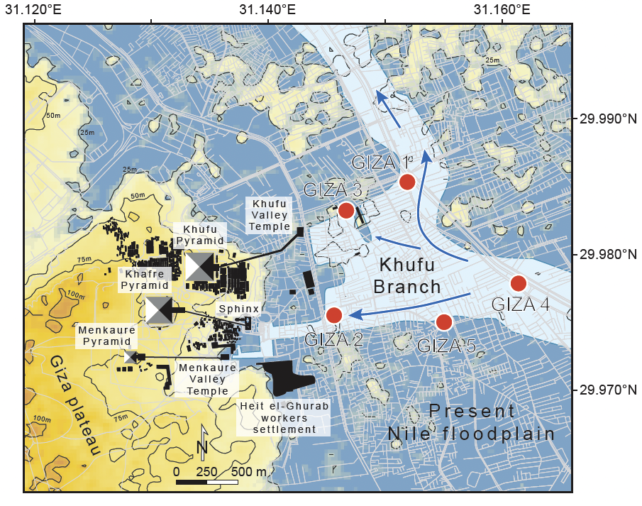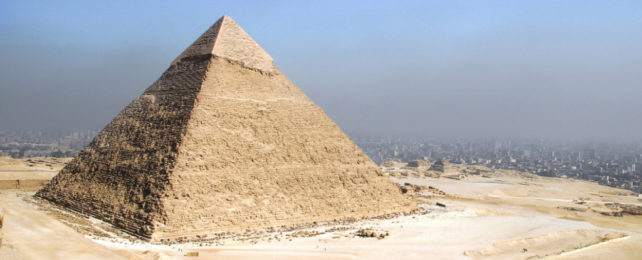Seeing the famed pyramids of Giza as they stand today – immovable, impenetrable fortresses surrounded by windswept sands and a sprawling metropolis – it's hard to imagine the day they were built.
These stone labyrinths, constructed to honor the dead and carry them into the afterlife, were erected around 4,500 years ago without modern technology and with astounding precision.
But Egyptians needed a whole lot more than a few primitive ramps to ferry the hugely heavy stone blocks into position.
A new study suggests favorable environmental conditions enabled the construction of the pyramids of Giza, with an ancient arm of the Nile River serving as a navigable conduit for freight transport.
"To edify the plateau's pyramids, tombs, and temples, it now seems that ancient Egyptian engineers took advantage of the Nile and its annual floods, using an ingenious system of canals and basins that formed a port complex at the foot of the Giza plateau," physical geographer Hader Sheisha of Aix-Marseille University in France and colleagues write in their paper.
"However, there is a paucity of environmental evidence regarding when, where, and how these ancient landscapes evolved."
Archeologists have thought for some time that Egyptian pyramid builders might have dredged waterways from the Nile River to form canals and harbors, harnessing annual floods that would act like a hydraulic lift to transport building materials.
The port complex that archeologists hypothesize serviced the pyramids of Khufu, Khafre, and Menkaure currently lies more than 7 kilometers (or 4.3 miles) west of the present-day Nile River. The inlets also had to be deep enough to keep barges laden with stones afloat.
Core drillings taken during urban engineering works around modern-day Giza have yielded stratigraphic evidence of rock layers that are consistent with an ancient branch of the Nile extending towards the base of the pyramids.
But questions linger about how Egyptians engineered water access to the pyramids of Giza. At the time they were being built, northern Egypt was in the throes of some extreme climatic changes, with flash flooding repeatedly ravaging the Lost City of the Pyramids, Heit el-Ghurab, which housed seasonal workers.
In this study, the researchers turned to fossilized pollen grains to paint a more detailed picture of the river system as it ran millennia ago. Pollen grains can be preserved in ancient sediments and have, in other studies, been used to reconstruct past climates and vegetated landscapes that look wildly different today.
Extracting pollen grains from five cores drilled on the present-day Giza floodplain east of the pyramid complex, the team identified an abundance of grass-like flowering plants which line the banks of the Nile River and marsh plants that grow in lake-edge environments.
This, they say, reveals the presence of a permanent waterbody that cut through the Giza floodplain and swelled thousands of years ago.
From there, they traced the rise and fall of water levels in the Khufu branch of the Nile River over 8,000 years of Egyptian dynastic history, relating their results to other historical records.
"Our 8,000-y reconstruction of Khufu-branch levels improves understanding of fluvial landscapes at the time of the construction of the Giza Pyramid Complex," Sheisha and colleagues write.
"The Khufu branch remained at a high-water level… during the reigns of Khufu, Khafre, and Menkaure, facilitating the transportation of construction materials to the Giza pyramid complex."

But after the reign of king Tutankhamun, who ascended around 1349 to 1338 BCE, the Khufu branch of the Nile gradually declined until it reached its lowest documented levels in the last 8,000 years towards the end of the dynastic period.
That fall correlates with chemical markers in the teeth and bones of Egyptian mummies that similarly suggest an arid environment, along with other historical records.
Like with all archaeological studies, however, chronological date ranges – of pharaohs' reigns and environmental change – can vary widely, so we should take these results with a grain of salt.
But by linking environmental and historical data, the study provides much more direct evidence than when archaeologists looked for missing fractals – exquisite, self-repeating patterns found often in nature – to deduce that ancient Egyptians might have carved out river channels when building the Dahshur pyramids, further south of Giza.
"It is difficult to believe the gigantic footprint the Egyptians have left," University of Innsbruck geologist Arne Ramisch told New Scientist at the time.
The researchers behind this latest study suggest similar approaches could be used to reconstruct ancient waterscapes that lapped other Egyptian pyramid complexes, including the Dahshur necropolis, when these monumental edifices were built.
The research was published in PNAS.
